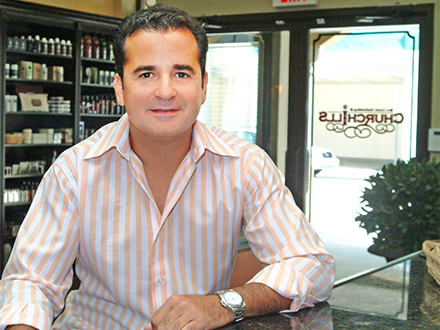
When Jose Goyanes isn’t casting a line off-shore or cruising Biscayne Bay, you’re likely to find him holding court at Churchill’s Barber Shop in downtown Miami.
A pioneer in Miami’s urban revitalization, the native Goyanes was a downtown business owner before owning a business in downtown was considered ‘cool.’
Today, Churchill’s is the go-to spot for well-groomed gentlemen in Miami, and Goyanes’ Metro Beauty Center is one of the top-performing retail shops in all of downtown.
He’s the original downtown Miami entrepreneur.
You’re a life-long Miami resident and a longtime downtown business owner – how has the community changed over the years?
Miami has become a big city with big city issues. The changes to the skyline are beautiful and the city has grown culturally with new museums and theaters. We now have a thriving food scene as well. More people want to live here than ever before, especially in downtown, and that has led to fast growth and the growing pains that come with it.
How did you get your start as a downtown entrepreneur?
Having lived and worked in New York after college, I saw downtown Miami as a mini version of New York with better weather. We had foot traffic on the streets and there was opportunity in the real estate market at the time with more tourists and residents arriving. Opening a business in the area was a no brainer, but I needed to figure out the right product and services to offer. That led me to open Metro Beauty Supply and Churchill’s Barber Shop.
You’ve always been a hands-on advocate for quality of life improvements at street-level. What initiatives are you engaged in today?
When you operate a business at street-level in downtown, you are exposed to the peaks and valleys of an urban marketplace. You are more in tune and aware of the social issues that affect quality of life and the customer experience. Working with the Downtown Development Authority, we’ve created a “Downtown Enhancement Team” which creates job opportunities for formerly homeless residents who work hard to keep our streets clean. We’ve also teamed up with local government to provide bathrooms at the street level for anyone to use – including those living on the street. The mobile bathroom project, “PitStop,” is one of the most innovative programs in downtown Miami history. I’m proud to be involved, both from an entrepreneurial and a humanitarian standpoint.
What are some of your favorite ‘hidden gems’ in Miami – where can we find you when you’re not holding court at Churchill’s?
There are so many interesting Miami neighborhoods, from the Grove to Wynwood and everywhere in between. I love Sapore Di Mare in the Grove and Miam Cafe in Wynwood has the best breakfast burritos in town. You’ll find the best hometown beer at J Wakefield Brewery. The Corner Bar in Downtown has great cocktails, and of course you’ve got to hit Garcia’s on the River for fresh seafood.
You also love boating, so what are some things that Miami can do to become a more welcoming place for boaters?
We need more affordable, transient dockage for boaters and more restaurants on the water. Our local government needs to work with the business community to expand access to the waterfront so that all can enjoy the best that Miami has to offer. The new vision for the Rickenbacker Marina is a step in the right direction, as it will bring new restaurants and more amenities for boaters while also welcoming the general public. The City of Miami was wise to usher in this project, and Marina PARC’s plans for the redevelopment would be a change for the better.
